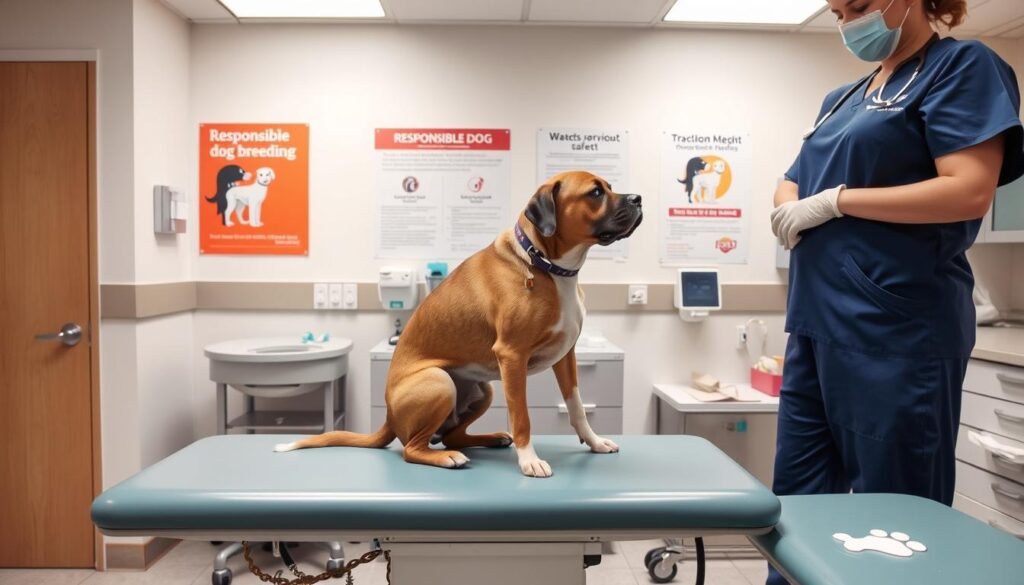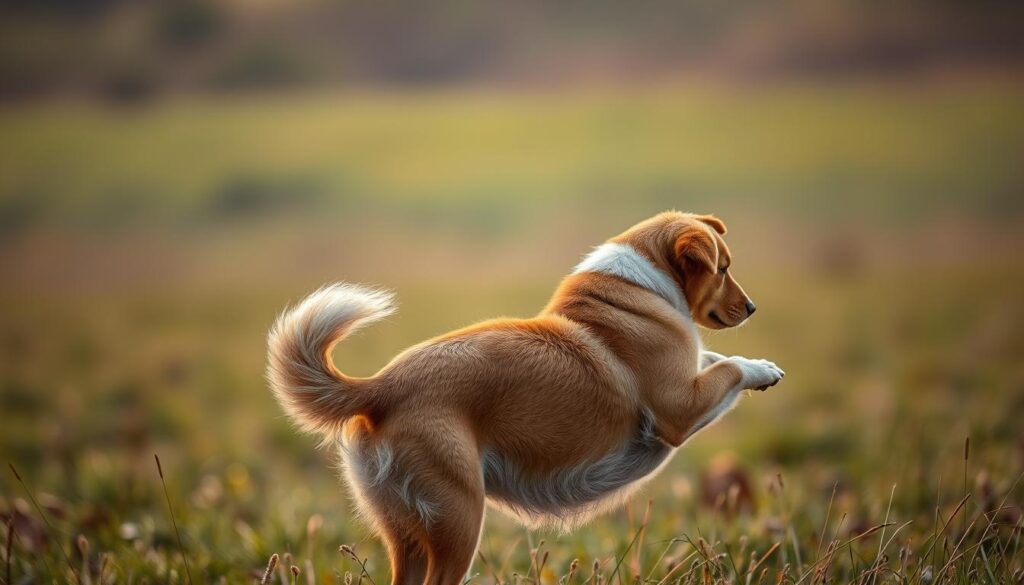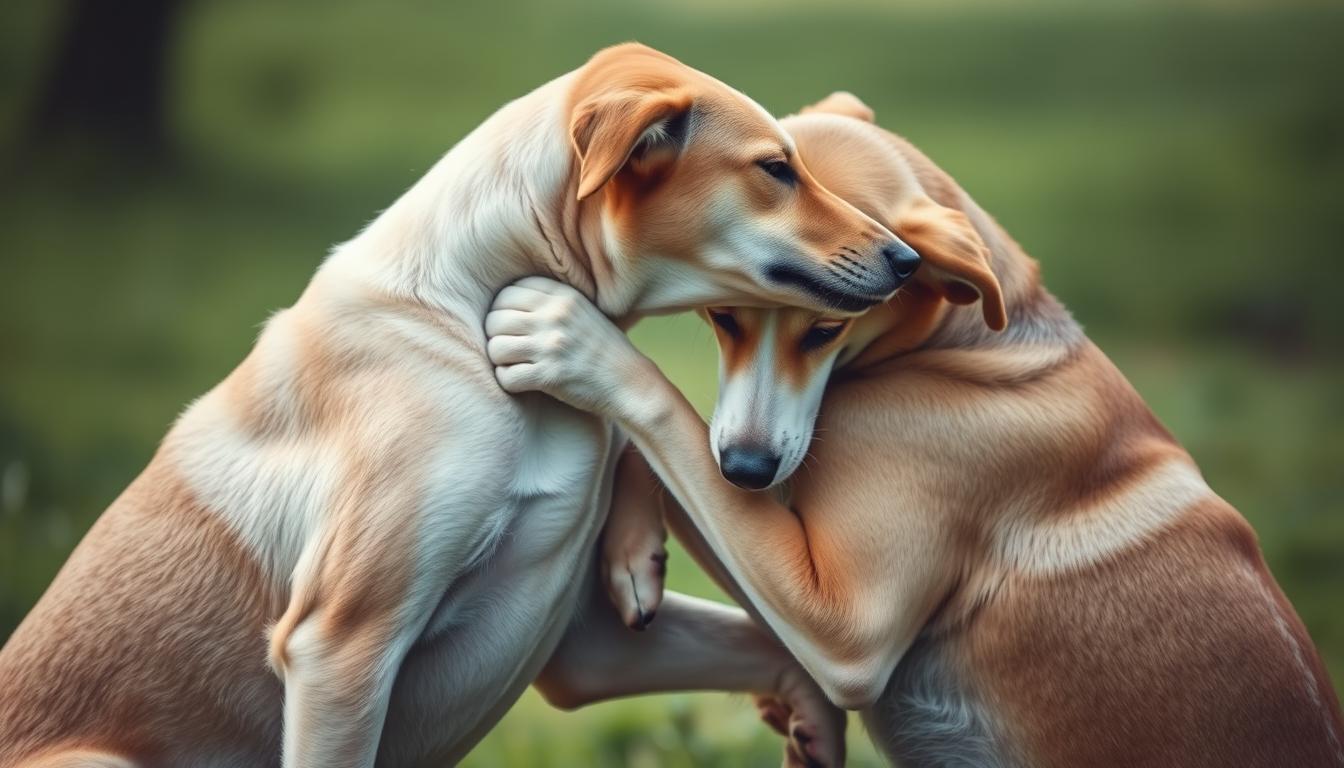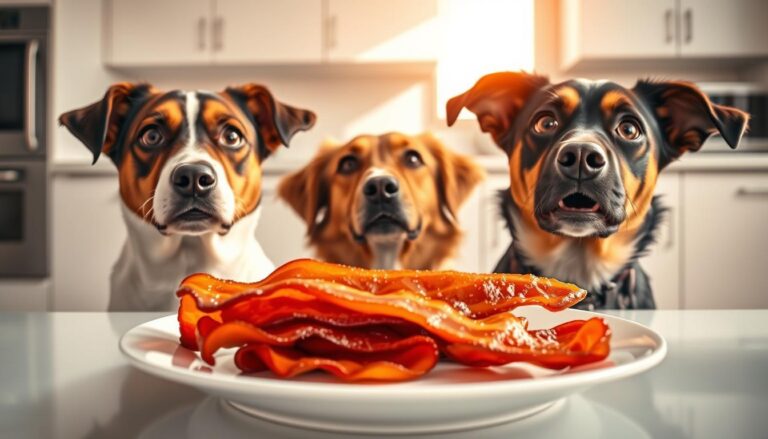Why Do Dogs Get Stuck Mating? The Science Behind It
Ever wondered about dogs mating behavior? As a dog owner, I’ve seen dogs get stuck together during mating. This natural event, called “the tie,” can be puzzling and scary for those who don’t know what’s happening.
When dogs get stuck mating, it’s a normal part of their biology. The swelling of the male dog’s reproductive organ creates a temporary bond. This might seem odd, but it’s crucial for their survival. Knowing why dogs get stuck mating can make you feel more at ease and informed about their reproductive cycle.
This article will explore the science behind dogs mating behavior. We’ll look at the biological, hormonal, and evolutionary reasons for this unique mating strategy. Whether you’re a breeder, a curious pet owner, or just interested in animal biology, you’ll learn a lot.
We’ll dive into the hormonal and physical changes during mating. You’ll discover the amazing science behind dogs’ reproductive process. Get ready to learn about the incredible mechanisms that help our canine friends thrive.
Table of Contents
Understanding the Natural Process of Canine Mating
Canine reproduction is a complex process involving hormonal and physical changes. Dogs prepare to mate through intricate mechanisms. These ensure the continuation of their species through biological signals.
Dog breeding habits show a system of hormonal interactions guiding mating. Knowing these mechanisms helps dog owners and breeders understand the reproductive cycle.
Hormonal Triggers in Dog Mating
Hormones are key in canine reproduction. During a female dog’s heat cycle, hormonal changes signal her readiness:
- Estrogen levels rise, preparing the reproductive system
- Progesterone increases to support potential pregnancy
- Luteinizing hormone triggers ovulation
Physical Transformations During Mating
Dogs undergo significant physical changes during mating. These changes ensure successful reproduction:
- Male dogs develop a swollen penile bulb
- Female dogs experience vaginal muscle contractions
- Reproductive organs become engorged with blood
Typical Mating Duration
A normal dog mating encounter lasts 10-30 minutes. This includes the “tie” phase, where dogs are physically connected. This maximizes the chance for successful fertilization.
Understanding these dog breeding habits shows the amazing biological process of canine reproduction.
What Is the “Tie” in Dog Mating?
Understanding dog mating means knowing about the “tie” or “lock.” This is a key part of how dogs reproduce. It often surprises pet owners and breeders.
Dogs have a special connection called “buttoning” during mating. This happens because of a part called the penile bulb. It helps keep the male and female dogs together for a while. This ensures the sperm can fertilize the egg properly.
- The tie typically lasts between 10-30 minutes
- It’s a completely normal part of the dog’s reproductive cycle
- The process prevents sperm leakage and increases fertility chances
When dogs are tied, it’s important not to pull them apart. Forcing them apart can hurt both dogs. The locked position helps sperm get to the egg better. This makes it more likely for the female to get pregnant.
The penile bulb gets bigger during mating. This creates a natural “lock” that keeps the dogs together. This swelling helps keep the sperm inside the female’s body. It’s a way nature has helped dogs reproduce better.
Nature has designed this intricate process to optimize the chances of successful reproduction in canines.
Why Do Dogs Get Stuck Mating: The Biological Explanation
Dogs have a unique way of mating that might seem odd to us. But it’s a key part of their biology that helps them reproduce. This process has evolved over time to ensure they can have babies.
The act of dogs getting stuck during mating is a complex event. It involves many physiological responses. This complex mechanism has been shaped by thousands of years of evolution.
The Function of the Penile Bulb
When a male dog gets excited, his penile bulb grows a lot. This growth creates a lock that keeps them together. It’s a key part of their mating process.
- Rapid increase in bulb size
- Precise anatomical fit within the female’s reproductive tract
- Preventing premature separation during crucial reproductive moments
Vaginal Muscle Response
The female dog’s body also plays a big role. Her vaginal muscles contract in sync with the male’s bulb. This helps in several ways.
- Grip the male’s penile bulb
- Maximize potential for successful fertilization
- Create a secure environment for sperm transfer
Evolution’s Role in the Process
Natural selection has made this mating behavior even better. The lock helps in several ways.
- Reducing sperm displacement
- Extending the time for potential fertilization
- Protecting reproductive investments
This amazing biological strategy shows how nature ensures species survival through precise reproductive mechanisms.
The Duration of Dog Mating Lock
When dogs mate, they go through a special process called the mating lock. This is key for successful breeding. It helps deliver sperm well and boosts fertilization chances. The dogs stay connected for about 15 to 30 minutes.
Knowing about the mating lock is important for dog owners. The time can change based on several things:
- Breed size and characteristics
- Individual dog physiology
- Age of the breeding dogs
- Overall reproductive health
It’s best to let the dogs be during this time. Trying to separate them can hurt both animals. The lock lets sperm move well and boosts conception chances.
Vets say to watch the dogs but don’t interfere. Keep them in a calm place. If you see any trouble, talk to a vet who knows about dog health.
“Nature has designed the mating lock to maximize reproductive success in dogs.” – Veterinary Reproductive Specialists
Female Dog’s Heat Cycle and Mating Readiness
It’s important to know about a female dog’s reproductive cycle for successful breeding. The heat cycle tells us when a dog is ready to mate and possibly get pregnant.
Dogs usually have heat cycles twice a year. But, this can change based on breed and individual dog. Smaller breeds might cycle up to three times a year, while bigger breeds cycle once a year.
Recognizing Signs of Estrus
Female dogs show clear signs when they’re ready to mate:
- Swollen vulva
- Mild vaginal discharge
- Increased urination frequency
- Changes in behavior and temperament
- Attractive scent to male dogs
Optimal Breeding Time
Finding the best time for breeding is key. The most fertile time is during the proestrus and estrus stages of the heat cycle.
| Heat Cycle Stage | Duration | Breeding Potential |
|---|---|---|
| Proestrus | 7-10 days | Not receptive to mating |
| Estrus | 7-10 days | Most fertile, receptive to mating |
| Diestrus | 60-90 days | No longer fertile |
Professional breeders use special methods to find the best breeding time. This helps ensure successful breeding and avoids mating problems.
Safety Measures During Dog Mating

When dogs mate, it’s crucial to keep them safe. You want to make sure they’re in a place where they feel comfortable and safe. This helps prevent stress and injuries.
Here are some important safety tips for dog breeding:
- Always watch over the mating process, especially with new dogs
- Choose a quiet, calm spot for breeding
- Keep away any sudden noises or distractions
- Don’t try to pull dogs apart during mating
Dog breeding needs patience and close watching. Never try to pull dogs apart during mating. The natural tie is how they reproduce. Trying to force them apart can hurt them badly.
Professional breeders suggest these extra safety tips:
- Make sure the breeding area is clean and comfy
- Watch both dogs for any signs of trouble
- Have a vet’s number ready
- Make sure both dogs are healthy and have had the right tests
Knowing how dogs mate means understanding they’ll separate on their own. Your job is to create a safe space. This helps reduce stress and problems.
The key to successful dog breeding is patience, observation, and understanding of natural canine reproductive processes.
Common Complications in Dog Mating
Dog breeding is complex and can lead to unexpected challenges. It’s important for pet owners and breeders to know about potential mating issues. These can come from physical and behavioral factors that need careful attention and expert advice.
Dog mating can cause several problems that might need vet help right away. Spotting these issues early can help avoid serious health problems for both dogs.
Potential Mating Challenges
- Aggressive behavior between dogs
- Unsuccessful mating attempts
- Physical injuries during breeding
- Infection risks
- Psychological stress for dogs
When to Seek Veterinary Help
You should call a vet right away if you see:
- Prolonged pain during or after mating
- Excessive bleeding
- Signs of distress in either dog
- Unusual discharge
- Difficulty separating after mating
Prevention Strategies
To prevent breeding complications, take proactive steps:
- Do thorough health checks
- Make sure dogs are mature and ready
- Watch dogs closely during mating
- Keep breeding areas calm and controlled
- Get advice from experts
Getting professional advice can greatly lower risks and make breeding better for your dogs.
The Science of Successful Dog Breeding
Understanding dog reproduction is complex and requires a scientific approach. The mating process in dogs involves intricate biological mechanisms. These mechanisms are key to breeding success. Experienced breeders know timing and genetics are crucial for the best results.
Key factors for successful dog breeding include:
- Precise tracking of female dog’s reproductive cycle
- Understanding hormonal changes during estrus
- Genetic health screening of breeding pairs
- Evaluating physical fitness of potential breeding dogs
Veterinary professionals suggest several steps to improve breeding. Ovulation timing is crucial in canine reproduction. Female dogs are most fertile when their vaginal discharge turns watery. This is the best time for mating.
Genetic diversity is also vital in responsible breeding. Choosing breeding partners with different traits helps avoid health issues. Genetic testing can show potential health problems, helping make better breeding choices.
Successful dog breeding combines scientific precision with compassionate animal care.
Professional breeders use advanced technologies to boost breeding success. Techniques like progesterone testing and artificial insemination can increase conception rates. They do this while keeping animal welfare at the highest level.
Natural vs. Supervised Mating in Dogs
Dog breeding needs careful thought to keep dogs healthy. Knowing the difference between natural and supervised mating helps make better choices for breeding.

Good dog breeding means using smart strategies to protect dogs during mating. Natural mating and supervised breeding each have their own benefits and challenges.
Benefits of Professional Breeding Assistance
Getting help from professionals is key in dog breeding. They offer many advantages:
- Genetic health screening
- Optimal timing for mating
- Reduced risk of injury
- Expert monitoring of reproductive health
Risk Factors to Consider
When looking at dog mating, there are risks to think about:
| Risk Category | Potential Concerns |
|---|---|
| Genetic Health | Inherited disorders |
| Age Considerations | Premature or delayed breeding |
| Physical Compatibility | Size and breed-specific challenges |
Professional advice can lower these risks, leading to safer and better breeding results. Not all dogs should be bred. Choosing wisely is key for keeping dogs healthy and diverse.
Post-Mating Care and Monitoring
After dogs mate, it’s important to care for them well. This care is key for both the male and female dogs. It helps avoid problems and ensures they can reproduce well.
The days after mating need careful watching and special care:
- Look for any signs of trouble or odd behavior in both dogs
- Keep their environment calm and stress-free
- Feed them well to support pregnancy
- Don’t let them do too much physical activity
Seeing a vet is very important after mating. If you think there was an accident or have breeding worries, call your vet right away. They can help with pregnancy prevention or confirm if the mating was successful.
Nutrition is very important during this time. If a female dog is pregnant, she might need different food. The vet might suggest special supplements to help her body change.
Look for early signs of pregnancy like:
- Small changes in how much they eat
- A bit of weight gain
- Less energy
- Behavior changes
Regular vet visits are crucial. They help catch any problems early and keep the mother and baby healthy.
Signs of Successful Mating in Dogs
Understanding dog mating means knowing the signs of a successful breeding. After mating, your female dog may show subtle changes. These changes suggest she might be pregnant.
Spotting pregnancy in dogs needs careful watching. Vets suggest looking for specific signs that show up after mating. Knowing why dogs get stuck mating helps when you understand their reproductive process.
- Physical changes in the female dog’s body
- Behavioral shifts indicating potential pregnancy
- Hormonal transformations
The early signs of successful mating include:
- Decreased activity levels
- Slight weight gain
- Changes in nipple appearance
- Increased appetite
Vets can confirm pregnancy with different tests. A professional ultrasound around 25-30 days after mating is the most accurate way to confirm successful reproduction.
Canine pregnancy is a delicate process that requires careful monitoring and professional guidance.
Your dog’s pregnancy usually lasts about nine weeks (63 days). During this time, it’s important to understand dog mating. This knowledge helps you care for your pregnant pet properly.
Conclusion
Dogs mating behavior is complex and natural. It’s key to canine reproduction. We’ve looked at why dogs get stuck during mating in this article. Knowing these details helps pet owners breed with confidence.
The “tie” or buttoning process is vital for successful fertilization. It might seem odd to us, but it’s normal for dogs. Understanding this can help you care for your breeding dogs better.
Getting help from vets and experienced breeders is crucial. They offer insights into canine reproduction. Breeding responsibly and scientifically supports your dogs’ health and well-being.
Every dog is different, and experiences can vary. Being informed and observant helps you handle canine reproduction better. This way, you can breed with more confidence.







